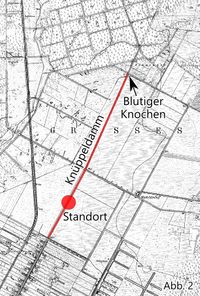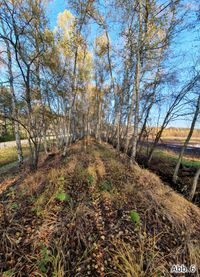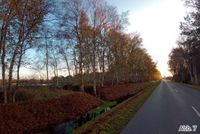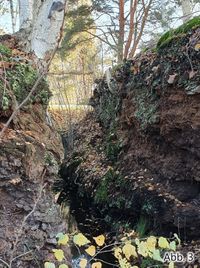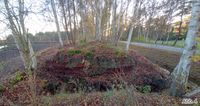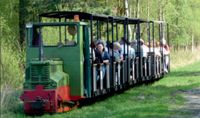The world ended at the Knüppeldamm
“In Wahrenholz they speak a completely different dialect of Plattdeutsch,” residents of Neudorf-Platendorf would report. There was no accessible track to Wahrenholz or Schönewörde (Fig. 2). Until 1960 there was only the Knüppeldamm (Fig. 6), a public track about 10 metres wide which was not upgraded until the district road was built in 1960 (Fig. 7).
What is a Knüppeldamm?
“Moorland tracks are often so worn through in places that not very much can be loaded and extra people have to be employed to throw birch shrubs in front of the wheels, i.e. to lay birch branches over precipitous spots to make them passable so that the vehicles were not damaged. Similarly – bowing to necessity – wooden shoes for horses were “invented” here.
This Knüppeldamm is no longer in use today and is overgrown with birch trees (Fig. 6). But it can still be clearly recognised.
The embankment is separated at the next ditch (Fig. 4). The structure of the peat layers in the moor from bottom to top is plain to see (Fig. 3): Fibric peat from the fens, from the creation of the Great Moor, black peat from 6,000 years and more growth of the raised bog and fibric or white peat from the last centuries.
Using the Knüppeldamm was onerous. There were still no rubber tyres for wheels, only iron-rimmed wooden wheels. Such a wagon, which was previously pulled by horses, is on display under the peat press (Fig. 5). The only way to pave the track was with staves (Knüppel). The floor of the track was made of peat, so there would otherwise have been absolutely no grip for a heavy carriage.
Before the Dorfstraße was built, a canal used to run between the villages of Neudorf and Platendorf, and this used to transport the peat. There was a track on either side of the canal, similar to the one on the Knüppeldamm. Report on 31 January 1863 by four residents of Gifhorn: “They found the road to be in such a pitiful state that they sunk in to the axle and feared they might topple over. They preferred to proceed on foot and witnessed two horses being lashed with the whip as they pulled a peat cart through moor and they remarked: “…Such misery, the torment has been continuing for many years … What sacrifice for man and beast, for time and money has this dreadful track already caused?”
Later, tracks were built on both sides of the Knüppeldamm, so that the Knüppeldamm was no longer needed to transport the peat to the railway station.
The Knüppeldamm once had an inn with the gruesome nickname “The Bloody Bone” (Fig. 2). And that was where the world ended.
Links to other stations in the museum - in English language:
<1> <2> <3> <4> <5> <6> <7> <8> <9> <10> <11> <12> <13> <14> <15> <16> <17> <18> <19> <20> <21> <22> <23>
